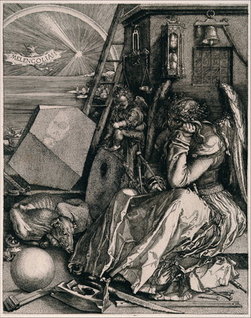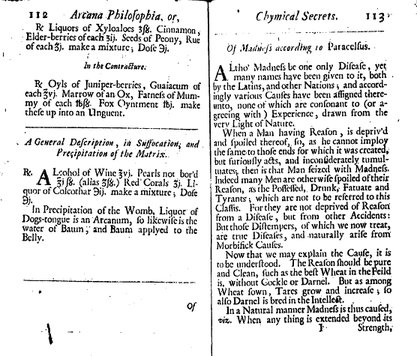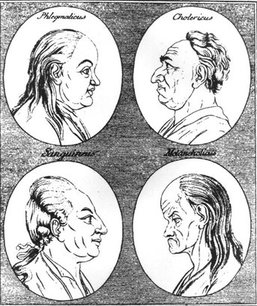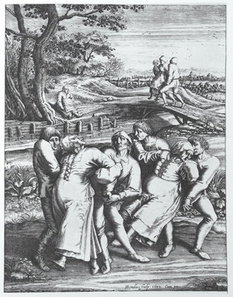Diagnoses
While the mentally ill were often just said to suffer from “madness” or “lunacy,” by the eighteenth century two mental illness had been distinguished and described. These were known as melancholia and mania. While some believed that the two were linked and simply different manifestations of the same disease, others felt that they were two separate conditions.
The body was believed to contain within it and be controlled by nervous fibers, circulating essential humors, and animal spirits. It was believed that emotions and body movements were governed by the movement of these fibers and fluids. The organic fibers included nerves and vessels as well as other unnamed fibrous structures within the body. The humors were four essential fluids in the body that included choler or bile (gastric juice), phlegm (all colorless secretions), blood, and black bile or melancholy 1. Animal spirits were another important fluid sent from the brain and circulated throughout the body. Gideon Harvey, writing in 1699, stated “the Brain may very probably be esteem'd the source, as being the highest scituated; whence the Animal Spirits do forcibly rush out into all the chanals, humors, and parts of the body” 2. It was a combination of problems with these body elements that was believed to cause mental illness.
Melancholy was a concept first described in the 17th century. Before the 18th century melancholy was used to refer generally to insanity, but as theories of insanity developed further it was only used to refer to depressive symptoms. Melancholy was “an extreme mental disturbance. Anguish and dejection were its essential elements, but also involved were powerful emotions springing from hallucinations and sensations of suspicion, mistrust, anxiety, and trepidation” 3. Common to it were elements of delirium where melancholics would be obsessed with one particular thought to the point where they would withdraw from society altogether. “Melancholics love solitude and shun company; this makes them more attached to the object of their delirium or to their dominant passion, whatever it may be, while they seem indifferent to anyone else” 4.

Melancholy was first thought to be be caused by a buildup of the dark humor or black bile. This build up of the dark humor was supposed to cause depression, anger, and general symptoms of madness. Others theorized that since blood was another main humor of the body when it moved sluggishly it caused melancholia. “ Heavy, clogged blood that the heart labors to distribute through the organism- has difficulty penetrating into the very fine arterioles of the brain where the circulation ought to be very rapid in order to maintain the movement of thought” 5. Still others believed that the “tension of nerves, vessels and the entire system of organic fibers” was slack when someone was in the state of melancholy 6. They believed that the melancholic’s natural fibers did not vibrate or react to stimulus as frequently as other people. The final theory of what caused someone to experience melancholia was the poor circulation and dark shadowy quality of their animal spirits. “Oppress the Animal Spirits, dull their motion, and cause such a disorder in their blood, that is productive of such symptoms, which commonly Melancholic Hypochondriacs are troubled with as sighing, heavy, sorrowful and desponding thoughts, palpitations of the Heart, frights, fears, sloathfulness in stirring, [and] languidness” 7.
The opposite mental disorder a person in this time could suffer from was mania. Some early psychologists thought that melancholia and mania were intertwined or one was causative of the other, but all agreed that the two illnesses were complete opposites. Mania is essentially everything melancholia is not. “It is a condition marked by excess and uncontrollability, it [finds] vent in fury, excitement, and cheerfulness” 8. It could include episodes of intense rage, expressions of grandiosity, and overwhelming feelings of euphoria. Those suffering from mania could seem inhuman in their ability to withstand adverse conditions. “They are in no wise subject to fevers, taking cold, obstructions of any of their bowels, or scarce any other distemper, or any preternatural symptom, except overwakefulness” 9. While the melancholic suffers from obsessive thoughts with one focus, the maniac often experiences racing unfocused thoughts.
Theories of the cause of mania were also the opposite of those for melancholia. Those who believed in the humor theory thought mania was caused by a “wasting of the humors and by a general aridity in the entire organism” 10. Instead of a build up of one or more humors, the maniac was too dry and lacked the essential body fluids. Those who went along with the theories involving the natural fibers that make up the body thought that maniac’s fibers had more tension than those of a normal person. “Mania was thus a tension of the fibers carried to its paroxysm, the maniac a sort of instrument whose strings by the effect of an exaggerated traction, began to vibrate at the remotest and faintest stimulus" 11. Maniacs were believed to have accumulated great amounts of energy in their fibers, which is why they could stand extreme temperatures of heat or cold. The final theory involving animal spirits posited that mania was caused by an excess or continuous violent movement of these essential fluids. Harvey wrote "The Animal Spirits in the brain being irregularly and violently mov'd, is the cause of Mania. The fury and heat, which Maniacs are so frequently impell'd into, are occasion'd by the continuated, quick, and impetuous motion" 12.
While we now classify the symptoms seen in melancholy under the disease Depression, mania is still a diagnoses given today. They are still seen as opposites, but in one disorder known as Bipolar Disorder, individuals experience both symptoms of depression and mania. Though these disorders are now categorized and treated differently there is no denying the vast contribution of early psychologists in the eighteenth century to our understanding of mental disorders today.


